

About Critical Thinking. Critical Thinking Model 1. To Analyze Thinking We Must Identify and Question its Elemental Structures Standard: Clarityunderstandable, the meaning can be grasped Could you elaborate further?
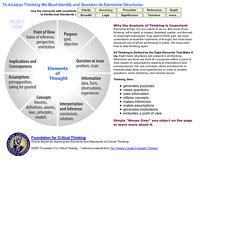
Could you give me an example? Asking_the_Right_Questions.pdf. Interactive Graphic Organizers. Graphic Organizer Interactives & 18 Literacy Strategy Site (Vermilion Parish) Slide 1 - Leading_and_Managing_DI.pdf. Curriculum_compacting. Bloom's Taxonomy, Example.pdf. Using Graphic Organizers To Differentiate Instruction.
Curriculum_compacting. 6_Ch2 Purposeful Planning.indd - 5_ch2 purposeful. Lesson Design. The Differentiator. Try Respondo!

→ ← Back to Byrdseed.com The Differentiator The Differentiator is based on Bloom's Taxonomy, Kaplan and Gould's Depth and Complexity, and David Chung's product menu. Try It In: French Dutch • Tweet It • Like Byrdseed • Pin It Students will judge the ethics of the [click to edit] using a textbook and create an essay in groups of three. Revised Bloom's Taxonomy adapted from "A Taxonomy for Learning,Teaching, and Assessing: A Revision of Bloom's Taxonomy of Educational Objectives" by Anderson and Krathwohl Depth and Complexity adapted from The Flip Book by Sandra N.
Depth Big Idea Unanswered Questions Ethics Patterns Rules Language of the Discipline Essential Details Trends Complexity Multiple Points Of View Change Over Time Across the Disciplines Imperatives Origin Convergence Parallels Paradox Contribution Key Words Consequences Motivations Implications Significance Adapted from David Chung and The Flip Book, Too by Sandra N. Group Size One Two Three Four. Scrapbook_ForPDF.indd - 2010DIScrapbook. Instructional Strategies That Support Differentiated Instruction - ACM-Leadership-Instructional-Strategies.pdf.
McGraw-Hill Answers. Sometimes an organization determines that its culture has to be changed.

For example, the current environmental context has undergone drastic change and either the organization must adapt to these new conditions or it may not survive. In fact, it is no longer sufficient just to react to change. Today, as was pointed out in this chapter about organizational learning, organizations must have a culture that learns and anticipates change. New product development, advanced information technology and the economy are changing so rapidly that any examples would be soon out-ofdate.
However, if the appropriate organization culture is in place, then such rapid change can be welcomed and accommodated with as little disruption and as few problems as possible. 1. 2. 3. The potential (high probability) cultural clash from M&As will be greatly compounded when the partners are from different countries. Critical Thinking Model 1. Instructional Strategies That Support Differentiated Instruction - ACM-Leadership-Instructional-Strategies.pdf. Critical Thinking Model 1. Scrapbook_ForPDF.indd - 2010DIScrapbook.
Scrapbook_ForPDF.indd - 2010DIScrapbook. Four Corners. Undefined 1.
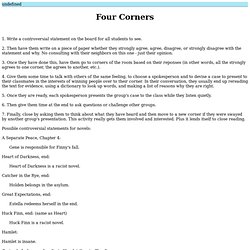
Write a controversial statement on the board for all students to see. 2. Then have them write on a piece of paper whether they strongly agree, agree, disagree, or strongly disagree with the statement and why. No consulting with their neighbors on this one - just their opinion. 3. 4. 5. 6. 7. Possible controversial statements for novels: A Separate Peace, Chapter 4: Gene is responsible for Finny's fall. Heart of Darkness, end: Heart of Darkness is a racist novel. Catcher in the Rye, end: Holden belongs in the asylum. Great Expectations, end: Estella redeems herself in the end.
Huck Finn, end: (same as Heart) Four Corners Teaching Strategy. Four corners is a teaching strategy that works well to engage all students in conversations about controversial topics.
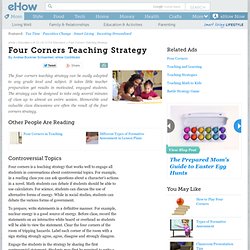
For example, in a reading class you can ask questions about a character’s actions in a novel. Math students can debate if students should be able to use calculators. For science, students can discuss the use of alternative forms of energy. While in social studies, students can debate the various forms of government. To prepare, write statements in a definitive manner. Untitled. Description: Total Possible Score: 5.00 Synthesis of the Six-column Framework Total: 1.25 Distinguished - Provides a thorough explanation of the benefits of the six-column framework.
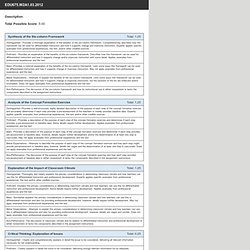
Comprehensively describes how this framework can be used for differentiated instruction and how it supports change and improves instruction. Proficient - Provides an explanation of the benefits of the six-column framework. Basic -Provides a minimal explanation of the benefits of the six-column framework. Below Expectations - Attempts to explain the benefits of the six-column framework. Non-Performance -The discussion of the six-column framework and how its instructional use is either nonexistent or lacks the components described in the assignment instructions. Analysis of the Concept Formation Exercise. 6600_gregory_2_ch_1. NONE. 6600_gregory_2_ch_1. Professional Learning Communities - Defining elements of a PLC? Elements that Define a PLC?
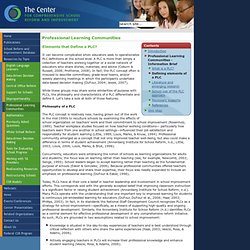
It can become complicated when educators seek to operationalize PLC definitions at the school level. A PLC is more than simply a collection of teachers working together or a social network of educators who share stories, materials, and advice (Coburn & Russell, 2008; Protheroe, 2008). In fact, the PLC concept often is misused to describe committees, grade-level teams, and/or weekly planning meetings in which the participants undertake data-based decision making (DuFour, 2004; Jessie, 2007).
While these groups may share some similarities of purpose with PLCs, the philosophy and characteristics of a PLC differentiate and define it.